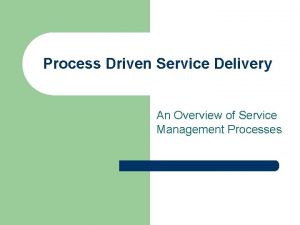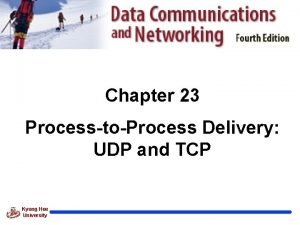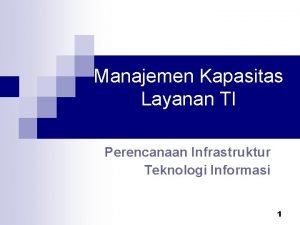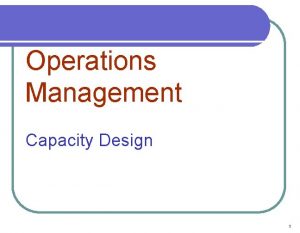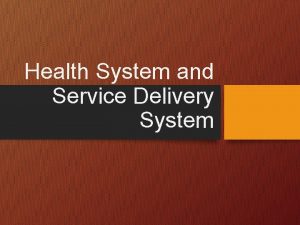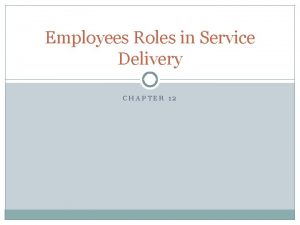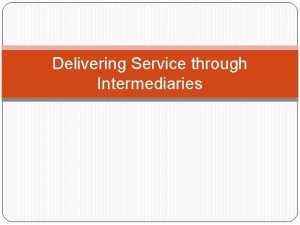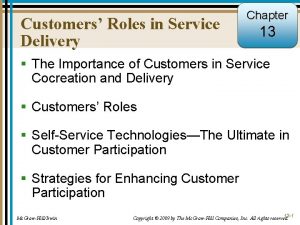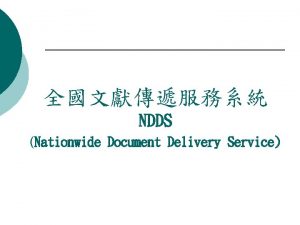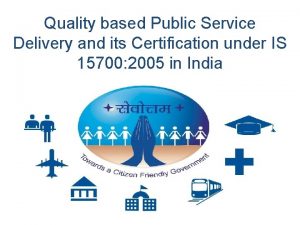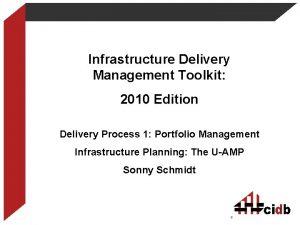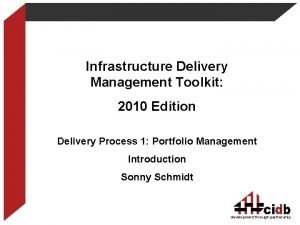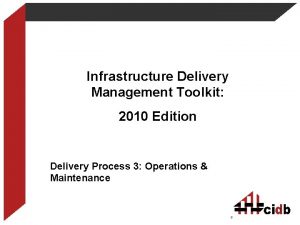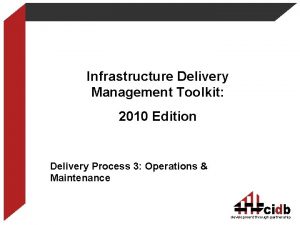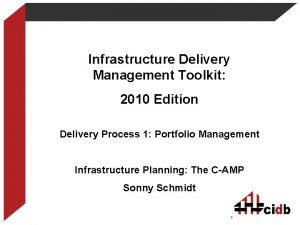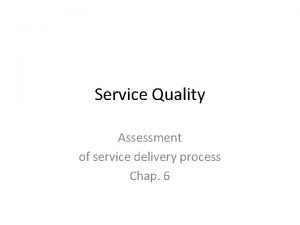Service delivery process Capacity Management Capacity Management Ajith





























- Slides: 29

Service delivery process Capacity Management • • Capacity Management Ajith G. S: poposir. orgfree. com

Service delivery process Capacity Management • Ensure that IT capacity meets current and future business requirements of the organisation in a cost-effective way. • It is the process of planning, analysing, sizing, and optimising capacity to satisfy demand in a timely and cost effective manner. • It provides the required capacity for data processing and storage at the right time and in appropriate volume. • Ensures the efficient use of IT infrastructure. • Improper planning for capacity may lead to wastage of resources, resulting in unnecessary cost or may lead to shortage of resources which may be responsible for poor performance or the unavailability of an IT service. • Focuses on both business and end-user on capacity requirements. Ajith G. S: poposir. orgfree. com

Service delivery process • • • Capacity Management It continuously tries to optimise existing and future IT resource demands and supply, and ensures the balance between them. It proactively adds components, space or people in a cost-effective manner while guaranteeing better performance for new additions and older components. Capacity management is aligned with the business case and planning process. Three main elements of capacity management: Inputs: Usual inputs include business plans, processes, technology and related information used by each of the sub-processes. Sub-processes: These are the levels of analysis where capacity is considered. Outputs: Capacity plans, databases, reports, changes and recommendations are the main outputs of the sub-processes. Ajith G. S: poposir. orgfree. com

Service delivery process Capacity Management • • Management tasks involved in capacity management process. Various management tasks involved in capacity management process. Are: Monitoring Analysis Modelling Optimising Change Initiation • • a. Monitoring It monitors utilisation of each resource and service regularly to make sure that each hardware and software resource is being used optimally. It helps to ensure that everything is happening as agreed in service level agreement document. • Ajith G. S: poposir. orgfree. com

Service delivery process • • • Capacity Management tasks involved in capacity management process. b. Analysis Data collected during the monitoring phase need to be analysed and used to carry out tuning exercises and to establish profiles. Analysis activity helps in identifying the following issues: Contention in data, file, memory, processor Inappropriate distribution of workload across available resources Inappropriate locking strategy Inefficiencies in the application design. c. Modelling It relies on the data obtained from other capacity management sub-processes and activities. Particularly, it gets data from forecasts of workloads and the use of resources by applications in development and associated hardware specifications. Ajith G. S: poposir. orgfree. com

Service delivery process • • Capacity Management tasks involved in capacity management process. Modelling techniques with the effective use of simulation software helps in investigating capacity planning in order to build a model that simulates the desired outcome. d. Optimising Analysis of data may identify important areas that could be tuned and optimised to make better use of the system resources or to improve the performance of a particular service. Optimising techniques include balancing workloads, balancing disk traffic, defining an accepted locking strategy and efficient use of memory. e. Change Initiation It implements changes to the services that have been identified by the analysis and tuning activities. Includes the identification of the necessary changes and subsequent generation and approval of change requests. Ajith G. S: poposir. orgfree. com

Service delivery process • • • Capacity Management Process involved in Capacity Management a. Business Capacity Management It is responsible for ensuring that the future business requirements for IT services are well considered, planned and implemented in a cost effective and timely manner. It is connected to service level management and works jointly with the business planning efforts of the organisation. b. Service Capacity Management It addresses the issues of IT services. Responsible for ensuring that the performance of all services is monitored and measured properly as discussed in service level management. c. Resource Capacity Management Concentrates on the technology components and supports the service provisions. It ensures that all components with declared finite resources are monitored and measured accurately. Ajith G. S: poposir. orgfree. com

Service delivery process • • • Capacity Management Advantages of Capacity Management Reduced Risk: Effectively management of the resources reduces the risks associated with existing service and monitors the performance of the resources continuously. Reduced Cost: It helps in making the decision of any investment at the appropriate time, neither too early nor too late, which results in reduced service cost. Greater Efficiency: Since demand supply are balanced at an early stage, this results in a greater degree of efficiency. Reduced Business Disruption: Due to the close connection with change management, it reduces business disruptions by preventing urgent changes resulting from inadequate or incorrect capacity estimates. Cont… Ajith G. S: poposir. orgfree. com

Service delivery process Capacity Management • Advantages of Capacity Management • Improved Customer Satisfaction: It consults the customers at an early stage and anticipates the requirements efficiently, ensuring better customer satisfaction • Better Validation of IT Spending: Ensures avoidance of incorrect capacity sizing which results in appropriate use of resources and sufficient capacity availability in time to meet production workload needs. • Improvement of Relationship with Suppliers: Purchasing, delivery, installation and maintenance agreements can also be planned more productively and effectively Ajith G. S: poposir. orgfree. com

Service delivery process • • • Capacity Management Cost of Capacity Management Following is the list of various components where investment is needed to be done: a. Cost of Software and Hardware: Includes the cost of purchase of hardware and software tools, which includes monitoring tools, trending and modelling tools for simulations and statistical analysis, reporting tools, capacity management database etc. b. Project Management Cost: Cost associated with the implementation of the project management process. c. Cost of Training: Cost incurred in providing personnel training and to develop support base. d. Facilities and Services: Includes the cost of facilities used and cost of services provided. Ajith G. S: poposir. orgfree. com

Service delivery process • • • Capacity Management Relationship with Other Processes With Service Level Management: Helps in feasibility study of service levels, defining OLAs, monitoring and measuring the performance levels and supplies information With IT Service Continuity Management: Gets information regarding minimum capacity required for disaster recovery, judging performance level when countermeasures are executed. With Financial Management: Gets many valuable information for the tasks such as budgeting, cost benefit analysis, investment decisions etc for costeffective implementation. With Availability Management: Has close relation with availability management processes. They both use many common tools and techniques to identify faults in the components. Ajith G. S: poposir. orgfree. com

Service delivery process Availability Management • Availability Management Ajith G. S: poposir. orgfree. com

Service delivery process Availability Management • Availability refers to the ability of a service or component to perform the function as desired at a stated instant or over a stated period of time. • The goal is to make sure that any given IT service delivers its functions consistently and cost-effectively as the customer requires. • It optimises the capability of the IT infrastructure, services and supporting organisation to deliver a cost effective and sustained level of service availability that meets business objectives. • It ensure that the processes used for the support of IT services are mature enough and have the necessary personnel, skills, and tools to take effectively on their responsibilities. Ajith G. S: poposir. orgfree. com

Service delivery process Availability Management • If there is a difference between supply and demand, then availability management may have to provide a solution. • Ensures that the achieved availability levels are improved continuously. • Availability management focuses on two distinct areas: • New IT Service: Propose the requirements from the very beginning and design a system accordingly. • Existing IT Service: Existing system is appended with required changes when demand arises. Ajith G. S: poposir. orgfree. com

Service delivery process Availability Management • Processes Involved in Availability Management Defining Service Level Requirements Proposing Availability Solution Formalising Operation Level Agreement Ajith G. S: poposir. orgfree. com

Service delivery process • • • Availability Management Processes Involved in Availability Management A. Defining Service Level Requirements Understand the availability targets of the customer before agreeing. Determine the cost of downtime or unavailability of the required IT service, so that a feasible IT budget can be set up. A complete study of individual elements and identify the functions that are the most critical. Determining Critical Customer Functions Business functions or transactions need to be studied carefully and ranked in an order to identify the most important and critical once. Customers' requirements should be compared with what can be provided by the organisation. In case of any mismatch, the cost impact of this should be determined. Ajith G. S: poposir. orgfree. com

Service delivery process • • • Availability Management Processes Involved in Availability Management A. Defining Service Level Requirements Determining the Availability Requirements Defining 'HOW' the IT organisation can fulfil the customer requirements. This process must be carried out before a SLA is concluded and should address both new IT services and changes to existing services. This activity consists of the following: Define key business requirements Identifying and negotiating the periods of downtime for planned maintenance activity, technology upgrades and the introduction of new business functions Identifying quantifiable availability requirements Defining the business hours of the customer Setting up agreement about maintenance channels Ajith G. S: poposir. orgfree. com

Service delivery process • • • Availability Management Processes Involved in Availability Management B. Proposing Availability Solution Once the availability requirements are identified with a clear view of its importance and financial implications, the process of designing IT Infrastructure can be started. This process involves six major steps: Identification of major IT service components Availability design Recoverability design Maintenance management Development of availability plan Measurement and reporting Ajith G. S: poposir. orgfree. com

Service delivery process • • • Availability Management Processes Involved in Availability Management B. Proposing Availability Solution a. Identification of IT Service Components The available IT services are divided into manageable components and these components are dealt with individually. For example, Microsoft Operations Framework [MOF] breaks down the infrastructure into components like Service, Application, Middleware, OS, Hardware, Network, Facilities, Egress b. Design for Availability For each identified component, the life cycle for each component is studied in detail. This helps in obtaining the maximum IT services that a component can provide. Study of each component can be done in two aspects: Availability risk and countermeasures Lifecycle management needs Ajith G. S: poposir. orgfree. com

Service delivery process Availability Management • Processes Involved in Availability Management • c. Design for Recoverability • So there is a need of a recovery plan which can be used in case of an incident such as an unexpected event or even in the failure of a countermeasure to protect a service. • Incident life cycle stages: Incident occurrence Incident detection Incident diagnosis Incident repair Service recovery Normal service restoration Ajith G. S: poposir. orgfree. com

Service delivery process • • Availability Management Processes Involved in Availability Management d. Maintenance Management Maintenance refers to all technical, administrative and managerial actions during the lifecycle of a component intended to retain it in, or restore it to, a state in which it can perform the required function. Maintenance management characterises the process of leading and directing the maintenance. Normally, when an organisation provides IT services, it keeps a scheduled time for windows unavailability, when normal services are not available to customers. This period is utilised for system changes and preventive actions, such as software and hardware upgrades. The maintenance must be carried out when the impact on services can be minimised. Ajith G. S: poposir. orgfree. com

Service delivery process • • Availability Management Processes Involved in Availability Management e. Developing the Availability Plan Availability plan is a long-term plan concerning the availability of the IT services in next few years. At the initial stage, availability plan describes the existing state and at a later stage, it can be enlarged to include the activities for improving the existing service and guidelines. It can also be enlarged to include plans for new services and guidelines for maintenance. f. Measuring and Reporting They provide the foundation for verifying service agreements, resolving problems and defining proposals for further improvements. The metrics commonly used in availability management are MTTR, MTBF, MTBSI Ajith G. S: poposir. orgfree. com

Service delivery process Availability Management • • Mean Time To Repair (MTTR) Known as the downtime. It is defined as the average time between the occurrence of a fault and service recovery. This metric is concerned with the recoverability and serviceability of the service. • • Mean Time Between Failures (MTBF) Known as uptime. It is the average time required between the recovery from one incident and the occurrence of the next incident. This metric is concerned with the reliability of the service. • • Mean Time Between System Incidents (MTBSI) It is defined as the mean time between the occurrence if two consecutive incidents. Ajith G. S: poposir. orgfree. com

Service delivery process Availability Management • C. Formalising Operating Level Agreements • When an IT organisation and the customer agree on a cost-effective level of availability, the agreement needs to be formalised. • This agreement document is called Operating Level Agreement (OLA); which helps in defining the SLA. • To define an effective OLA, the mechanism for reporting availability back to the customer, the degree of granularity required, the format of presentation and the frequency of reporting need to be formally agreed upon. Ajith G. S: poposir. orgfree. com

Service delivery process • • Availability Management Advantages of Availability Management It aims to maximise the availability of IT services and customer satisfaction within the defined constraints. Benefits of availability management include: Ensures that new products and services fulfil the availability requirements and standards that are agreed with the customer. The associated cost is acceptable. It makes sure that the availability standards are monitored continuously and improved. In case of the unavailability of the service, it ensures that corrective action is taken and tries to minimise unavailability duration. It is easy to prove its added values for an organisation which follows availability management in providing its services. Ajith G. S: poposir. orgfree. com

Service delivery process Availability Management • Cost of Availability Management • The cost increases as the availability increases; hence, finding the optimum solution is an important job of availability management. • It is possible to reach an optimum with limited resources, rather than with significant investment. • In order to improve the availability, availability management should identify the areas where investment is needed. • It is important that a cost-benefit analysis is carried out in all cases wherever investment is needed. Ajith G. S: poposir. orgfree. com

Service delivery process Availability Management • The costs of availability management includes following major components: • Cost of Implementation: It includes cost of implementation of availability management in the organisation. • Personnel Costs: This is the cost incurred in providing training to personnel. • Facilities Costs: This is the cost which is required to provide various facilities to customers. • Cost of Measuring and Reporting Tools: It relates to the cost incurred in measurement and reporting tools. Ajith G. S: poposir. orgfree. com

Service delivery process Availability Management • Relationship with Other Processes • With Service Level Management: It negotiates and manages SLAs and OLAs; of which, availability is one component • With IT Service Continuity Management: Closely related as both processes work towards eliminating risks to the availability of IT service • With Financial Management: Ensures that solution proposed by availability management is justified in terms of cost versus benefit • With Capacity Management: It is concerned with ensuring IT resources are available to meet customer demands Ajith G. S: poposir. orgfree. com

Service delivery process Availability Management • Availability Ajith G. S: poposir. orgfree. com
 Dr ajith colonne
Dr ajith colonne Ajith aids
Ajith aids Cupola of diaphragm
Cupola of diaphragm Ajith sominanda
Ajith sominanda Ajith sominanda
Ajith sominanda Service delivery process in it infrastructure
Service delivery process in it infrastructure What is process to process delivery
What is process to process delivery Process-to-process delivery
Process-to-process delivery Features offered in adm website accenture
Features offered in adm website accenture Technology capacity
Technology capacity What is capacity design in operations management
What is capacity design in operations management Channel capacity planning
Channel capacity planning What is hospitality service delivery system
What is hospitality service delivery system Swot analysis on the online delivery
Swot analysis on the online delivery Social service delivery models
Social service delivery models Internal service delivery mechanism
Internal service delivery mechanism It service delivery and support
It service delivery and support Service delivery objective
Service delivery objective Fire service course delivery
Fire service course delivery Employee role in service delivery
Employee role in service delivery Effective service delivery
Effective service delivery Common issues involving intermediaries
Common issues involving intermediaries Customer role in service delivery example
Customer role in service delivery example Customer role in service delivery
Customer role in service delivery Service delivery network
Service delivery network Ebsco password
Ebsco password Electronic registered delivery service
Electronic registered delivery service Differentiated service delivery
Differentiated service delivery Sevottam model diagram
Sevottam model diagram Skynet 6 service delivery wrap
Skynet 6 service delivery wrap





